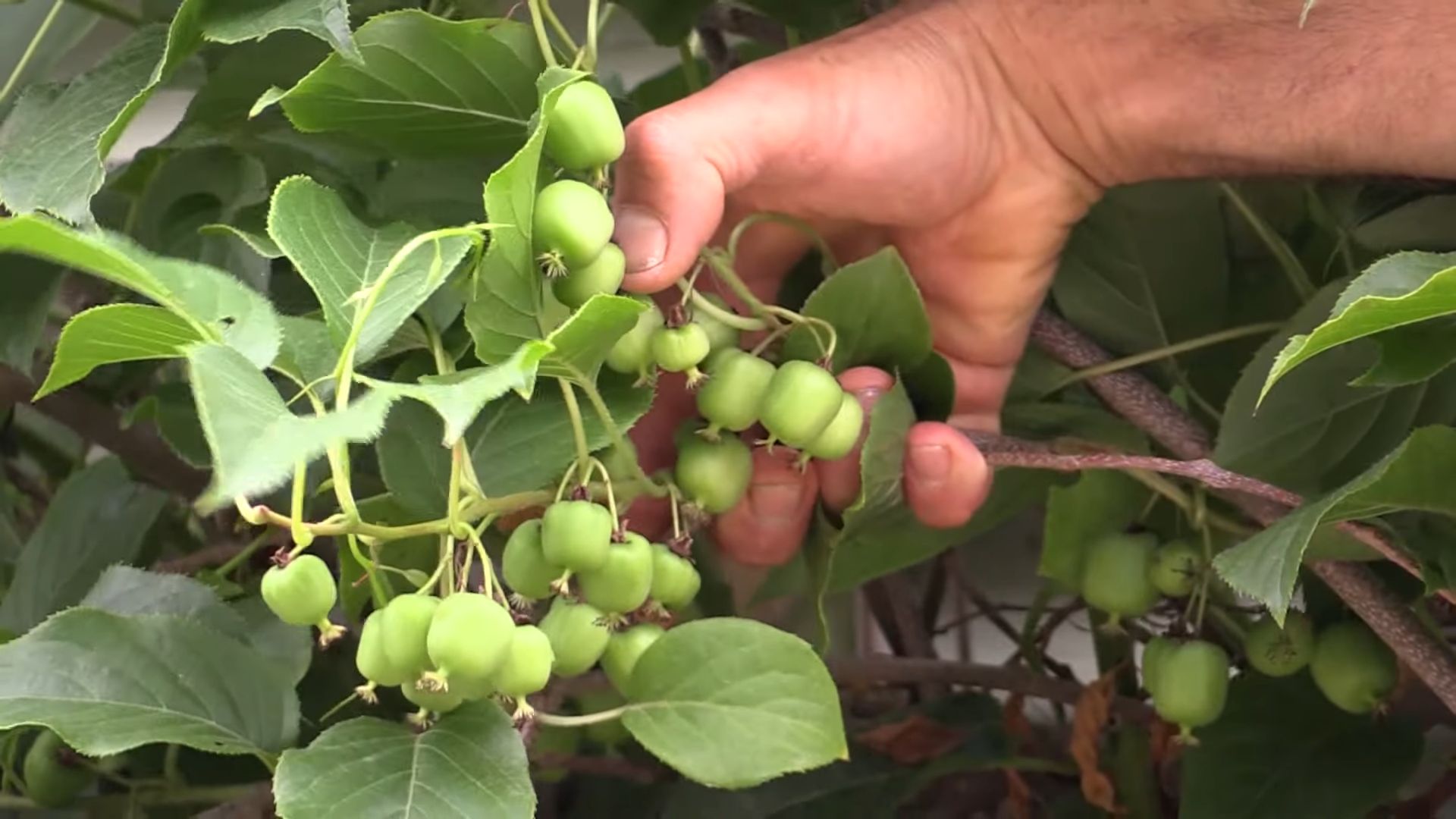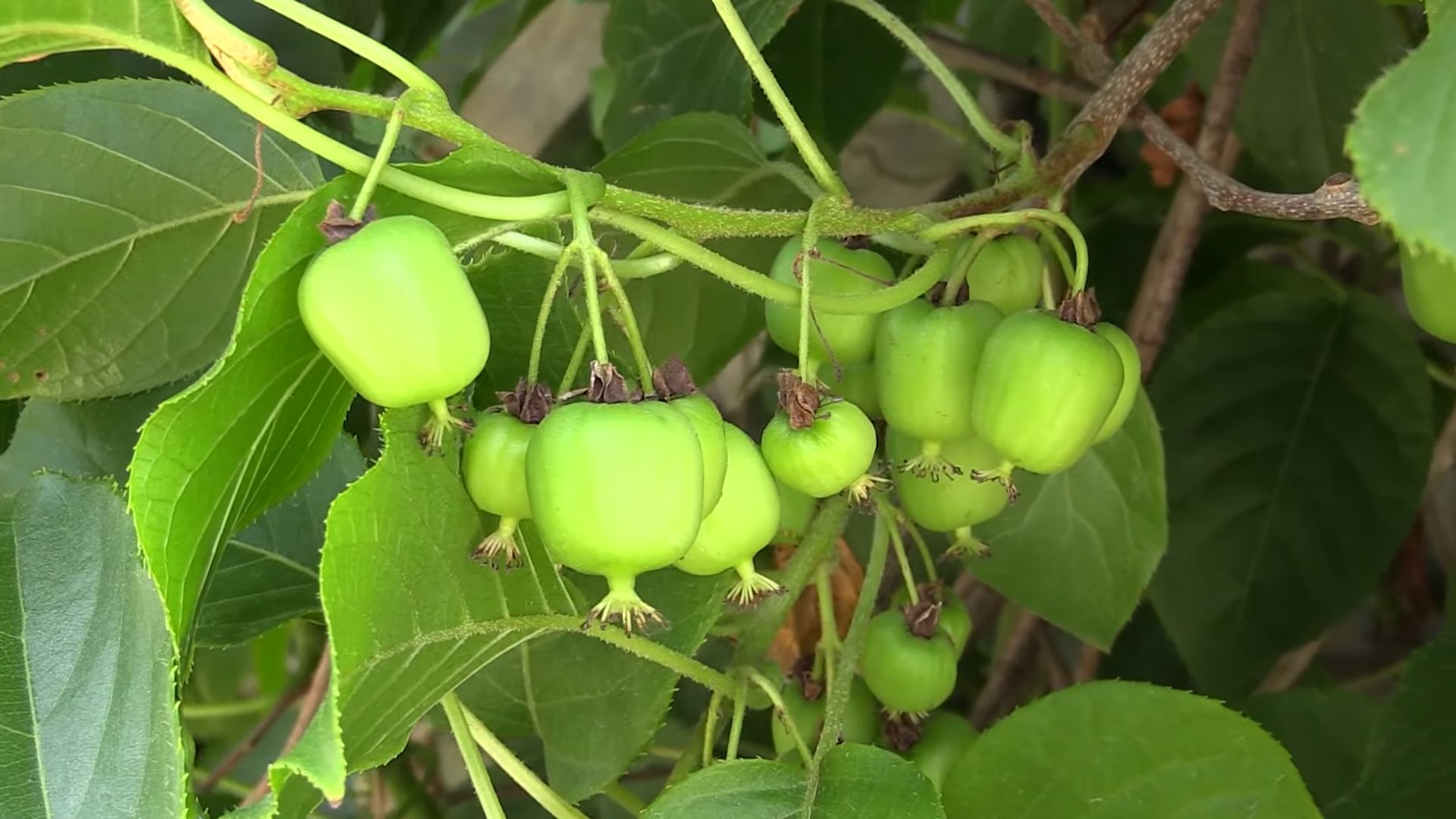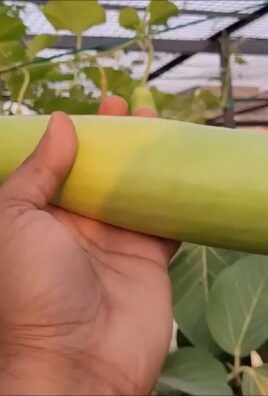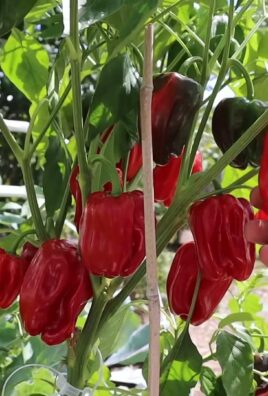Grow Kiwi at Home? Absolutely! Imagine plucking juicy, tangy kiwis fresh from your own backyard. Sounds like a tropical dream, right? Well, it’s more attainable than you might think! For centuries, the kiwi fruit, originally known as the Chinese gooseberry, has been cultivated in China, prized for its unique flavor and nutritional benefits. It wasn’t until the early 20th century that it made its way to New Zealand, where it was rebranded and popularized as the kiwi we know and love today.
But why should you bother trying to grow kiwi at home? Well, for starters, store-bought kiwis can be expensive, and their quality can vary. Plus, there’s nothing quite like the satisfaction of nurturing a plant from seedling to fruit-bearing vine. This DIY guide will provide you with simple, step-by-step instructions and clever hacks to successfully cultivate your own kiwi plants, even if you have limited space or gardening experience. We’ll cover everything from choosing the right variety to providing the perfect growing conditions, ensuring you’ll be enjoying homegrown kiwis in no time. Get ready to unleash your inner gardener and embark on this exciting fruity adventure!

Growing Kiwi at Home: A DIY Guide to Fruity Success!
Okay, so you want to grow your own kiwis? Awesome! It might seem a little daunting, but trust me, with a little patience and the right know-how, you can totally have your own kiwi vines thriving in your backyard (or even in containers!). I’m going to walk you through everything you need to know, from choosing the right variety to harvesting your delicious, homegrown fruit. Let’s get started!
Choosing the Right Kiwi Variety
Before you even think about planting, you need to pick the right kiwi variety for your climate. Kiwis are generally hardy in USDA zones 7-9, but there are some varieties that can tolerate colder temperatures.
* Hardy Kiwi (Actinidia arguta): These are the rockstars of cold climates! They can handle temperatures down to -25°F (-32°C). The fruits are smaller than the fuzzy kiwis you find in the store, but they’re super sweet and you can eat the skin! Popular varieties include ‘Issai’ (self-fertile, but produces more with a pollinator), ‘Anna’, and ‘Ken’s Red’.
* Fuzzy Kiwi (Actinidia deliciosa): This is the classic kiwi you’re used to. They need warmer climates and are generally only hardy to about 10°F (-12°C). You’ll need a male and female plant for pollination. ‘Hayward’ is a popular female variety, and ‘Matua’ is a common male pollinator.
* Golden Kiwi (Actinidia chinensis): These have smooth skin and yellow flesh. They’re less common and a bit more finicky, requiring warmer temperatures than fuzzy kiwis.
Important Note: Most kiwi varieties are dioecious, meaning they have separate male and female plants. You’ll need at least one male plant for every 6-8 female plants to ensure good pollination and fruit production. Some varieties, like ‘Issai’ hardy kiwi, are self-fertile, but even they benefit from having a pollinator nearby.
Preparing for Planting
Alright, you’ve chosen your kiwi variety. Now it’s time to get your planting site ready. Kiwis are vigorous growers and need plenty of space and support.
* Sunlight: Kiwis need at least 6-8 hours of sunlight per day.
* Soil: They prefer well-drained, slightly acidic soil (pH 6.0-7.0). Amend your soil with compost or other organic matter to improve drainage and fertility.
* Support Structure: Kiwis are vines and need a strong trellis or arbor to climb on. A T-bar trellis is a popular choice, but you can also use a fence or even a sturdy pergola. Make sure your support structure is built to last, as kiwi vines can become quite heavy.
* Spacing: Space your kiwi plants 8-15 feet apart, depending on the variety and the vigor of the vines.
Planting Your Kiwi Vines
Okay, the fun part! Let’s get those kiwis in the ground.
1. Dig the Hole: Dig a hole that’s twice as wide and as deep as the root ball of your kiwi plant.
2. Amend the Soil: Mix some compost or other organic matter into the soil you removed from the hole.
3. Plant the Kiwi: Gently remove the kiwi plant from its container and loosen any circling roots. Place the plant in the hole, making sure the top of the root ball is level with the surrounding soil.
4. Backfill the Hole: Fill the hole with the amended soil, gently tamping it down around the plant.
5. Water Thoroughly: Water the newly planted kiwi vine deeply to help settle the soil and encourage root growth.
6. Mulch: Apply a layer of mulch around the base of the plant to help retain moisture and suppress weeds. Keep the mulch a few inches away from the trunk to prevent rot.
7. Protect from Pests: Young kiwi vines are susceptible to damage from rabbits and deer. Protect them with a wire cage or netting.
Caring for Your Kiwi Vines
Now that your kiwis are planted, it’s time to give them the TLC they need to thrive.
* Watering: Kiwis need consistent moisture, especially during dry periods. Water deeply and regularly, but avoid overwatering, which can lead to root rot.
* Fertilizing: Fertilize your kiwi vines in the spring with a balanced fertilizer. Follow the instructions on the fertilizer label. You can also amend the soil with compost or other organic matter throughout the growing season.
* Pruning: Pruning is essential for kiwi vines. It helps to control their growth, improve air circulation, and promote fruit production.
* Winter Pruning: This is the most important pruning. Prune in late winter or early spring, before the buds start to swell. Remove any dead, damaged, or crossing branches. Shorten the fruiting canes (the ones that produced fruit the previous year) to 6-8 buds.
* Summer Pruning: This helps to control the vigorous growth of the vines. Pinch back the tips of new shoots to encourage branching and fruit production. Remove any suckers that grow from the base of the plant.
* Training: Train your kiwi vines to grow along your trellis or arbor. Tie the vines to the support structure with soft twine or plant ties.
* Pest and Disease Control: Kiwis are generally resistant to pests and diseases, but keep an eye out for problems like spider mites, scale, and root rot. Treat any problems promptly with appropriate organic or chemical controls.
Pollination: Ensuring a Bountiful Harvest
As I mentioned earlier, most kiwi varieties need both male and female plants for pollination. Here’s what you need to know:
* Male Plants: Male kiwi plants produce flowers with pollen. They don’t produce fruit.
* Female Plants: Female kiwi plants produce flowers that need to be pollinated by pollen from a male plant in order to develop fruit.
* Pollination Methods:
* Natural Pollination: Bees and other insects can pollinate kiwi flowers. However, kiwi flowers aren’t very attractive to bees, so you may need to hand-pollinate to ensure good fruit set.
* Hand-Pollination: This is the most reliable way to ensure pollination. Use a small paintbrush to collect pollen from the male flowers and transfer it to the female flowers. Do this on a dry, sunny day when the flowers are open.
Harvesting Your Kiwis
Finally, the moment you’ve been waiting for! Harvesting your own kiwis is so rewarding.
* Harvest Time: Kiwis are typically harvested in the fall, before the first frost. The exact harvest time will depend on the variety and your climate.
* Determining Ripeness: Kiwis are ripe when they soften slightly to the touch. You can also taste a few to see if they’re sweet enough.
* Harvesting Technique: Gently twist the kiwis off the vine. Be careful not to bruise them.
* Storage: Kiwis can be stored in the refrigerator for several weeks. You can also freeze them for longer storage.
Troubleshooting Common Kiwi Problems
Even with the best care, you might encounter some problems along the way. Here are a few common issues and how to deal with them:
* No Fruit Production: This could be due to several factors, including lack of pollination, improper pruning, or nutrient deficiencies. Make sure you have both male and female plants, prune correctly, and fertilize regularly.
* Yellowing Leaves: This could be a sign of overwatering, nutrient deficiencies, or pest infestations. Check the soil moisture, fertilize with a balanced fertilizer, and inspect the leaves for pests.
* Root Rot: This is caused by overwatering and poor drainage. Improve drainage by amending the soil with compost or other organic matter. Avoid overwatering.
* Pest Infestations: Keep an eye out for pests like spider mites and scale. Treat infestations promptly with appropriate organic or chemical controls.
Container Growing Kiwis
Don’t have a lot of space? No problem! You can grow kiwis in containers.
* Choose the Right Variety: Select a compact variety like ‘Issai’ hardy kiwi.
* Use a Large Container: Kiwis need plenty of room for their roots. Choose a container that’s at least 20 gallons in size.
* Use Well-Draining Soil: Use a potting mix that’s well-draining and contains plenty of organic matter.
* Provide Support: Provide a trellis or other support structure for the vines to climb on.
* Water and Fertilize Regularly: Container-grown kiwis need more frequent watering and fertilizing than those grown in the ground.
* Overwintering: In cold climates, you may need

Conclusion
So, there you have it! Growing kiwi at home might seem like a daunting task reserved for experienced gardeners, but with a little patience, the right setup, and this straightforward guide, you can absolutely cultivate your own delicious, tangy kiwis. This DIY approach isn’t just about saving money; it’s about connecting with nature, understanding the growth cycle of your food, and enjoying the unparalleled satisfaction of harvesting something you nurtured from a tiny seedling or cutting.
Why is this a must-try? Because store-bought kiwis, while convenient, often lack the intense flavor and freshness of homegrown fruit. Plus, you have complete control over the growing process, ensuring your kiwis are free from unwanted pesticides and chemicals. Imagine biting into a sun-ripened kiwi, bursting with flavor, knowing you grew it yourself! That’s an experience worth pursuing.
But don’t stop there! Experiment with different kiwi varieties to find your favorite flavor profile. ‘Hayward’ is a classic choice, known for its reliable production and excellent taste. However, consider exploring varieties like ‘Anna’ for colder climates or ‘Golden Kiwi’ for a sweeter, less acidic fruit. You can also experiment with different training methods for your kiwi vines. Espalier training, for example, is a great way to grow kiwis in a limited space, creating a beautiful and productive living fence.
Remember, growing kiwi at home is a journey, not a race. There will be challenges along the way, but the rewards are well worth the effort. From the delicate blossoms in spring to the abundant harvest in fall, you’ll witness the magic of nature unfold in your own backyard.
We wholeheartedly encourage you to give this DIY trick a try. Don’t be afraid to get your hands dirty, ask questions, and learn from your experiences. And most importantly, share your journey with us! We’d love to hear about your successes, your challenges, and any tips or tricks you discover along the way. Post photos of your kiwi vines, share your harvest stories, and let’s build a community of home kiwi growers. Together, we can unlock the secrets to successfully growing kiwi at home and enjoy the fruits (literally!) of our labor.
Frequently Asked Questions (FAQ)
What are the ideal growing conditions for kiwi vines?
Kiwi vines thrive in sunny locations with well-drained soil. They need at least 6-8 hours of direct sunlight per day to produce abundant fruit. The soil should be slightly acidic to neutral (pH 6.0-7.0) and rich in organic matter. Good drainage is crucial, as kiwi vines are susceptible to root rot in soggy conditions. Consider amending your soil with compost or well-rotted manure before planting to improve drainage and fertility. Also, keep in mind that kiwi vines are vigorous growers and need a sturdy support structure, such as a trellis or pergola.
How long does it take for a kiwi vine to produce fruit?
Patience is key when growing kiwi vines. It typically takes 3-5 years for a kiwi vine to begin producing fruit after planting. This timeframe can vary depending on the variety, growing conditions, and the age of the plant at the time of planting. Grafted plants tend to fruit sooner than those grown from seed or cuttings. Proper pruning and fertilization are essential to encourage fruit production. Be sure to provide adequate water, especially during dry periods, and protect the vines from frost damage.
Do I need both male and female kiwi plants to get fruit?
Yes, most kiwi varieties are dioecious, meaning they have separate male and female plants. You need at least one male plant for every 6-8 female plants to ensure proper pollination and fruit set. The male plant provides the pollen necessary for the female plants to produce fruit. Some self-fertile kiwi varieties are available, but they often produce smaller and less abundant fruit compared to those that are cross-pollinated. When purchasing kiwi plants, make sure to label them clearly to distinguish between male and female plants.
How do I prune kiwi vines?
Pruning is essential for maintaining the health and productivity of kiwi vines. The best time to prune is during the dormant season, typically in late winter or early spring before new growth begins. Remove any dead, damaged, or diseased wood. Thin out the vines to improve air circulation and sunlight penetration. Shorten the fruiting laterals (the branches that produce fruit) to encourage new growth and fruit production. Kiwi vines produce fruit on one-year-old wood, so it’s important to prune in a way that promotes the growth of new fruiting laterals each year.
What are some common pests and diseases that affect kiwi vines?
Kiwi vines are relatively pest-resistant, but they can be susceptible to certain pests and diseases. Common pests include spider mites, scale insects, and Japanese beetles. Diseases that can affect kiwi vines include root rot, botrytis blight, and bacterial canker. Monitor your vines regularly for signs of pests or diseases and take appropriate action if necessary. Organic pest control methods, such as insecticidal soap or neem oil, can be effective for controlling many pests. Proper drainage and air circulation can help prevent fungal diseases.
How do I protect my kiwi vines from frost?
Kiwi vines are susceptible to frost damage, especially during the spring when new growth is emerging. Protect your vines from frost by covering them with blankets or burlap sacks when frost is predicted. You can also use frost protection fabric or row covers. Water the soil around the vines before a frost, as moist soil retains heat better than dry soil. Avoid fertilizing the vines late in the season, as this can encourage new growth that is more susceptible to frost damage.
Can I grow kiwi vines in containers?
Yes, you can grow kiwi vines in containers, but it requires careful planning and management. Choose a large container (at least 20 gallons) with good drainage. Use a well-draining potting mix that is rich in organic matter. Provide a sturdy trellis or support structure for the vines to climb. Water regularly, especially during dry periods, and fertilize every few weeks with a balanced fertilizer. Container-grown kiwi vines may require more frequent pruning and repotting than those grown in the ground.
What is the best way to harvest kiwis?
Kiwis are typically harvested in the fall, when they are mature but still firm. The exact timing of the harvest will depend on the variety and the growing conditions. A good indicator of ripeness is the ease with which the fruit detaches from the vine. Gently twist the fruit; if it comes off easily, it’s ready to harvest. Kiwis can be stored in the refrigerator for several months. They will continue to ripen after harvest, so you can store them at room temperature for a few days to soften them before eating.
How can I encourage better pollination of my kiwi vines?
Ensure you have the correct ratio of male to female plants. Hand pollination can be done using a small brush to transfer pollen from the male flowers to the female flowers. This is especially helpful if there are few bees or other pollinators in your area. Planting flowers that attract pollinators near your kiwi vines can also help increase pollination rates. Avoid using pesticides that can harm pollinators.





Leave a Comment